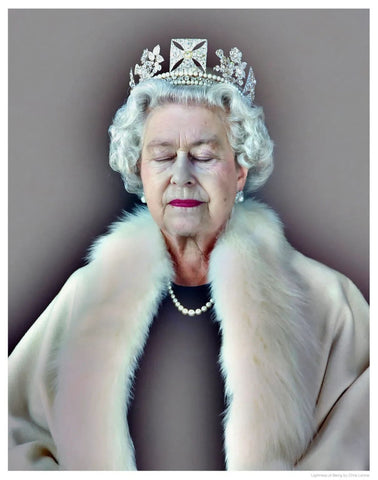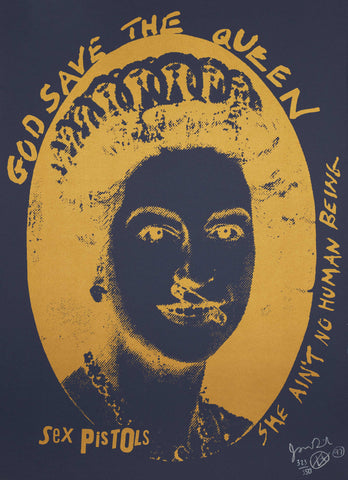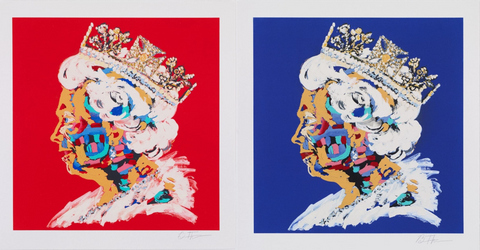As we bid goodbye to the Queen, we thought it only fitting that we pay tribute to the monarch by honouring her undeniable impact on the world of art.
A steady presence throughout our lives, The Queen has inspired untold artworks and her likeness has been reproduced in almost every conceivable medium. In fact, over the course of her 70-year reign, the Queen sat for more than 1000 artists, making her one of the most painted women in history.
The Queen’s history with Enter Gallery has also been illustrious. Over the course of our 30 year history, we’ve had innumerable images of the monarch adorning our walls, from James Cauty’s controversial Stamps of Mass Destruction to Banksy’s Monkey Queen.
Today, in tribute, we’re offering Enter Gallery’s 10-gun salute to some of the most famous depictions of the British monarch over the years.
1 - Lightness of Being, Chris Levine
This striking portrait of the Queen, seemingly emanating white light, is by South African artist, Chris Levine. To capture the image, ‘Master of Light’ Levine, used a state-of-the-art high-resolution digital lenticular camera that took 200 shots while moving in a 360 degree track around the Queen.
The ethereal image was captured purely by chance when Levine suggest the Queen rest between shots. It was only after the sitting that Levine realised he had captured her in this moment of absolute serenity. Speaking of the piece, Levine comments:
“I wanted the Queen to feel peaceful so I asked her to rest between shots; this was a moment of stillness that just happened. It has such an aura about it, a power.”
2 - God Save the Queen, Jamie Reid
Without a doubt the most iconic punk image of all time, God Save the Queen by Jamie Reid is a shoo in on this list. The piece originated in 1977, and was released as the artwork for the Sex Pistols’ single of the same name. The fact it was released on the year of the silver jubilee made it all the more provocative.
To create the artwork, Reid subverted a classic photograph of the monarch taken by royal photographer, Peter Grugeon. By ripping away her eyes and mouth and floating her over the Union Jack, Reid communicated the punk movement’s desire to tear down society, while inferring the monarchy’s blindness to the plight of the country.
3 – Queen Elizabeth II, Lucien Freud 
While opinion remains divided over this Lucien Freud portrait, we love it when a piece of art gets people talking. This painting is one of Freud’s smallest, measuring only nine by six inches, but its impact is undeniable, with the Queen’s face filling out the canvas.
Freud asked to paint the Queen and she sat for him over a six-month period at St James’s Palace. When the portrait was released, eyebrows were raised, with some declaring the expressive piece the ‘finest royal portrait for 150 years’ and others saying it made her look like one of her corgis. Some even suggested the portrait bared a resemblance to Freud himself.
The figurative artist delivered the portrait to the Queen in person, and while she didn’t express an opinion, she did say to Freud, “Very nice of you to do this. I’ve very much enjoyed watching you mix your colours.” Make of that what you will!
4 – Black Queen, Hew Locke
 Courtesy of Hew Locke
Courtesy of Hew Locke
Hew Locke has made many an artwork portraying Queen Elizabeth, all of which communicate an ambivalent opinion of the monarchy and Britain’s colonial legacy, stemming from his time spent living in Scotland, former British colony – Guyana, and Brixton.
Black Queen is an elaborate sculpture depicting the Queen’s head overrun with plants, insects and plastic lizards. The piece was created in the aftermath of the Iraq War and in response to the 7/7 bombings. It reflects on the anxious mind of the individual in a society burdened by stress and strain. The sculpture is built on a base of plastic M-16 machine guns, a recurring theme in Locke’s work, because, as he stated: “the United Kingdom is a nation at war and The Queen is the head of the army.”
5 - Annie Leibovitz

Infamous portrait photographer, Annie Leibovitz, was the first American invited to photograph the Queen, and proclaimed: “I felt that I had an advantage over every other photographer or painter who had made a portrait of her. It was okay for me to be reverent.”
The shoot made headlines when Leibovitz famously asked the Queen to remove her crown, saying it would make things ‘less dressy’. The Queen is reported to have responded by laughing, indicating her glitzy robes and asking the photographer, “what do you think this is!”
Leibovitz has taken a series of candid portraits over the years, portraying the Queen alone and with her family. While there are many beautiful shots to choose from, this one of the Queen with her corgis provides a relaxed glimpse at her life behind all the usual pomp and circumstance.
6 – Bradley Theodore
A far cry from the traditional type of portraiture usually associated with the Queen, this pair of colourful abstract portraits bring a modern touch to the Queen’s image.
Eternal Queen (Cardinal Red) and (Cobalt Blue) are a pair of works by American artist, Bradley Theodore, and are part of a series by the artist depicting royalty, past and present. Over a year in the making, the pair were created via a complex combination of etching and six layers of relief painting.
Speaking of the set, Theodore states:
“Queen Elizabeth has set the tone for fashion and lifestyle. She represents the strong, beautiful, powerful woman that is the archetype for women today.”
Shop Bradley Theodore
7 – Queen Elizabeth, Andy Warhol
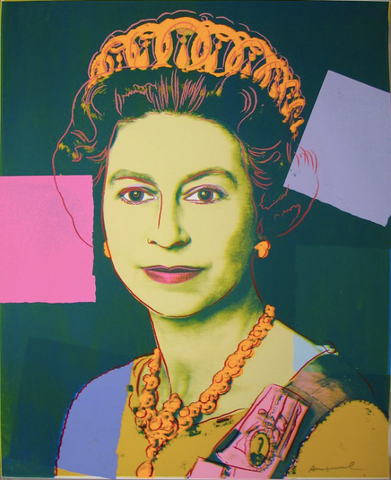
Andy Warhol, Queen Elizabeth (unique) (1985). Courtesy of Adamar Fine Arts
The Queen's image is one of the most widely-reproduced, with people in every corner of the world knowing exactly who she is. Therefore, it's only fitting we include an image from Andy Warhol, the King of artworks representing consumerism.
This piece is from Warhol’s Reigning Queens 1985 portfolio, which depicted all of the Queen’s ruling at the time of the portfolio’s creation: Queen Elizabeth II, Queen Beatrix of the Netherlands, Queen Margrethe II of Denmark and Queen Ntombi Twala of Swaziland.
To create the series, Warhol used official media photographs of each of the monarchs, with this one of Queen Elizabeth taken for the 1977 Silver Jubilee. The piece is undeniably Warhol, and is a wonderful example of his style of photographic silkscreens from the mid-1970s, which involved fragmenting images with overlaid shapes and patches of colour.
8 - Justin Mortimer
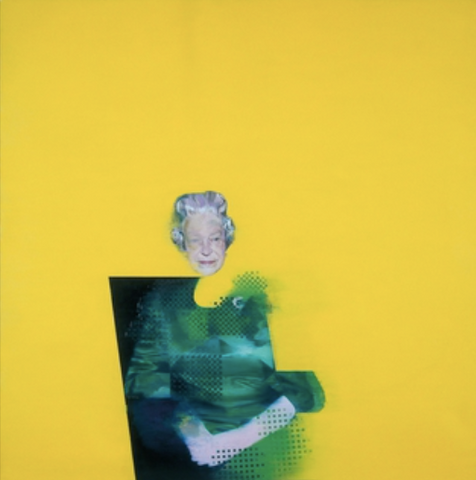
Courtesy of Justin Mortimer
The Queen has lived through one of the most progressive centuries in art history, so it makes sense that some of the portraits captured are less than traditional.
We love this piece by Justin Mortimer, which was commissioned by the Royal Society of Arts in 1997. Mortimer was just 27 when the Queen sat for him, and the artwork was first shown in the months immediately following the death of Princess Diana, one of the most trying periods in her reign.
Again, opinion was divided over this contemporary and colourful depiction, but the Queen herself obviously liked it as she later commissioned Mortimer to create another portrait of her Lord Chamberlain.
9 - Cecil Beaton
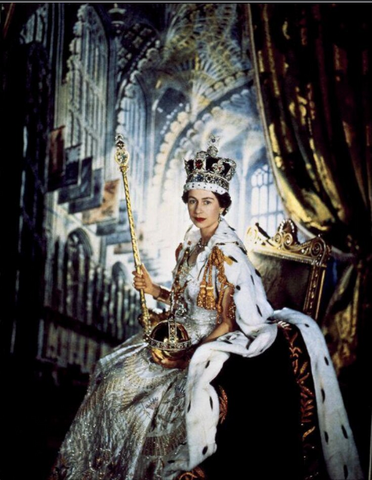
Cecil Beaton, Coronation Day (1953). Photo: Royal Collection Trust/© Her Majesty Queen Elizabeth II, 2015.
This official coronation portrait must have been the dream assignment for Cecil Beaton – a British fashion, portrait and war photographer, with a long list of other talents including being a painter, interior designer, and Oscar-winning stage and costume designer for film and theatre.
What makes this image so special is that at first glance it appears as though it is taken in the hallowed halls of Westminster Abbey. In fact, Beaton created his own extravagant theatrical backdrop so the shoot could take place in Buckingham Palace.
One of the first portraits of the new monarch, the Queen sports some of her finest jewels, including the imperial state crown, and the orb and sceptre, setting the standard for many a portrait to come.
10 - George Condo
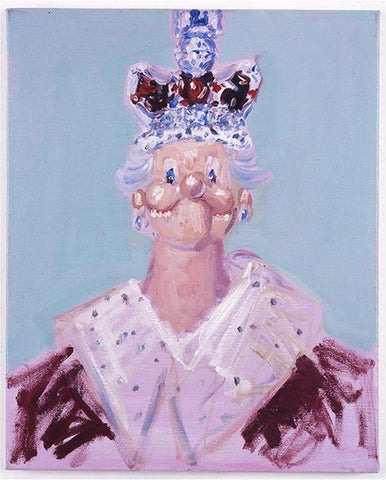
Photo: courtesy the artist, Simon Lee Gallery/Andrea Caratsch/Zurich and Luhring Augustine/Tate Modern.
The final portrait on our list is another contentious option - Dreams and Nightmares of the Queen by George Condo - an American visual artist who once worked for Warhol, rubbed shoulders with Basquiat, and more recently, designed album art for Kanye West.
First displayed in the Tate Modern’s Wrong Gallery, his 2006 portraits of the monarch caused wide-spread outrage when he depicted the Queen as (in Condo’s words), ‘A toothless cabbage patch doll’. Of course, the Queen maintained a dignified silence on the matter. Apparently, Condo originally wanted to paint the Queen as nude in the style of Diego Velazquez…so perhaps she felt she dodged a bullet.
Condo’s series of nine surreal portraits of the Queen, including one with a carrot sticking out of her ear and one of her shaped like a chess piece, sparked lively debate – with many debating whether there’s such thing as taking artistic license too far.
Explore our Royal Collection of artworks here.

